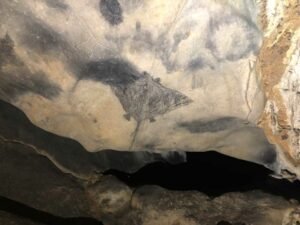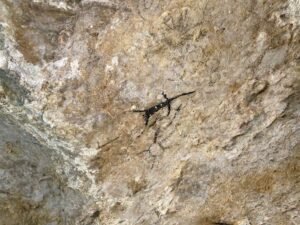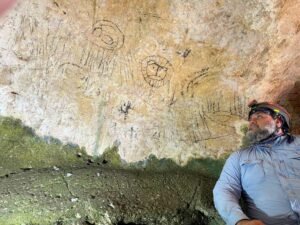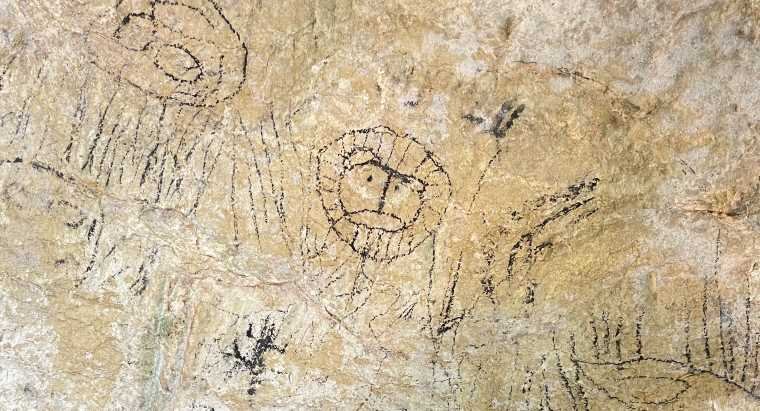A mysterious series of cave art drawings, which includes what resembles an African lion, has been discovered inside a Puerto Rican cave, according to a new study that raises questions as to why images depicting animals native to Africa would appear in Puerto Rico.
The same study also pushes back the dates of Puerto Rico’s first inhabitants by thousands of years. If confirmed, this finding directly contradicts previous estimates made by early European invaders, as well as later studies dating artifacts found in and around the caves.
Puerto Rican Cave Art Establishes Much Earlier Habitation Than Previously Believed
Much of Puerto Rico’s history is still unknown, but many natives say the commonly accepted dates for the island’s colonization are woefully inaccurate. Such discrepancies between traditional beliefs and modern historical timelines motivated the University of Puerto Rico (UPR) at Arecibo geophysicist Angel Acosta-Colon to search for more accurate dates of the cave art spread across the island using the latest scientific techniques.
“Many studies have been carried out to understand the chronology of various manifestations of rupestrian rock art of Puerto Rico,” Acosta-Colon explained in an October 2023 paper presented to the Geological Society of America, “but to refine the temporal resolution of rock art on the island, its antiquity has been approximated indirectly based on its spatial proximity to absolutely dated archaeological contexts.”
While dating sites based on the proximity of other datable artifacts is one tool available to researchers, there are more specific methods available. In this case, Acosta-Colon and his team decided to rely on the highly accurate method of Carbon-14 dating.


First, they selected 11 caves out of the more than 60 that contain various types of ancient drawings suspected of being from different periods of Puerto Rico’s history. Next, the collected samples of the pigments used to make the drawings, including the mysterious drawing of an African lion, to determine when the art was made.
Of course, the process of collecting the pigments was critical, as the researchers wanted to make sure not to damage the art in the process.
“[The pictographs] are not an infinite resource—they are limited,” explained Acosta-Colon in an announcement of the research’s findings. “So if we touch one, we touch it forever, and for the future generations, we are not allowing the pleasure of seeing what we see.”
After selecting artworks the team described as “commonly seen and not unique,” they collected tiny samples, about 1 to 2 mg each, of the pigments used to make the various drawings. A total of 61 pigments were sampled, focusing on the pictographs that used pigments, as opposed to the petroglyphs (etchings) and pyroglyphs (drawn with burnt material), which are forms of artwork that wouldn’t reveal Carbon-14 results.


Although the tests produced various ages for the pictographs, the first one to catch Acosta-Colon’s eye was the oldest date of 700-400 BC, also known as the Archaic Age. That date goes directly against the more commonly reported age of Puerto Rico’s first occupation by as much as two thousand years but is more consistent with the ages he and his colleagues hoped to find.
“That is very important to us because when the European Invasion came to Puerto Rico, they put in a document that our pre-colonial population was only there for 400 to 500 years,” says Acosta-Colon. “So this proves that we were here [thousands] of years before the European Invasion, and that is documented in science, not context archeology.”
Mysterious Drawing of An African Lion Likely Oldest Example of Puerto Rican Slave Art
Perhaps the most stunning finding was the mysterious drawing of an African Lion in one of the caves, an animal that shouldn’t be there. “We have an image that looks like a lion,” said Acosta-Colon, “but in Puerto Rico, we don’t have lions.”


After running a sample of the pigment used to draw the lion through their Carbon-14 test, the team discovered it was most likely drawn sometime around 1,500 A.D. As a result, Acosta-Colon and his team say they think the likeliest explanation for the presence of the lion was African slaves brought by the Spanish to Puerto Rico in the 1,500s.
“The age of the art is around 1500,” he says. “We have data to corroborate what, I think, is one of the first slave art in caves in Puerto Rico.”
Acosta-Colon admits the finding is “controversial.” However, he also notes his hypothesis of 500-year-old slave art is much likelier than the presence of native Puerto Rican lions in the 1,500s.
Moving forward, Acosta-Colon and his research team believe that further study of the cave art spread across Puerto Rico could push the date of the first occupation back to 5,000 BCE. But whatever dates these future tests reveal, the work they have already done not only seems to have solved the mystery of a lion drawing in Puerto Rico but also appears to have pushed the dates given by European historians much farther back into ancient history, fulfilling one of the team’s original goals.
“Normally, we get the European history version of Puerto Rico,” Acosta-Colon concludes, “but this is direct evidence that the story in Puerto Rico didn’t start with the European Invasion; it started much, much earlier in history.”
Christopher Plain is a Science Fiction and Fantasy novelist and Head Science Writer at The Debrief. Follow and connect with him on X, learn about his books at plainfiction.com, or email him directly at christopher@thedebrief.org.

